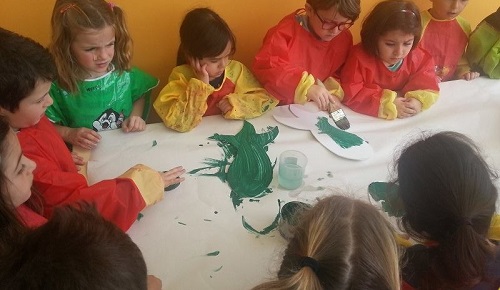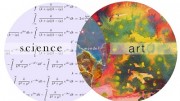by M.D.Mourtzini, BA, MiL.*
“In the beginning there was the Word.”[1]
“A Picture speaks a thousand words”[2].
The “Picture”, the “Word” and the implementation of different teaching approaches can provide a unique educational opportunity and experience.
Today’s technologically revolutionised world is characterised by an extended use of images, pictures and different types of visual materials. It is hard to even imagine what life was like without the cinema, the TV, photographs, mobile phones, computers, photocopies. Inevitably, visual aesthetics have also become a part of our everyday life.
The importance of Visual Arts has therefore become irrefutable. Teaching primary students the basic principles of Visual Arts is preparing them to face the challenges of today’s world and their future well equipped.
Visual Arts require the development and combination of different skills which in turn play an important role to a good education and self-fulfillment. Some of the most important skills are Creativity, Cognition, Communication, Content, Culture and Technique.
In Visual Arts, so far, teaching different Techniques has been the priority. Without disregarding its importance, a new emphasis is being placed to the development in parallel of teaching Creativity as well as Cognition, Communication, Content and Culture. These last four skills are the founding principles of a different teaching approach in foreign Languages known as Content and Language Integrated Learning or CLIL.
Teaching Visual Arts – Development of Skills
The field of Visual Arts is very wide and can provide knowledge and professional opportunities. Like any other field in human experience it has its own language and requirements.
Visual Arts are a language. In order to approach them, the above mentioned important skills are actually put into practice while working on an art project and especially in class. So, children, without realising it, are given the opportunity to actually develop them while they perform artistically.
“Wisdom cannot be contained. […] When we give freely of what we have learned, we teach by example, and the creative exchange that results fills us again and again with new understanding. […] Together, teaching and learning are the soul of creativity”[3].
“Creativity welcomes, initiates and survives change”[4] . It “is evolutionary and revolutionary.”[5] The understanding and teaching of Creativity is crucial to an emotionally balanced and fulfilled life as well as to good education and can help children benefit from what it can offer. Coupled with artistic technique it can become the means and a path for personal development and expression.
The desire to share this unique opportunity was based on a long teaching experience in both Children’s art workshops and the English language. It is coupled with an academic background in both fields of English Literature, Translation, Arts and Design which have proven an invaluable foundation for teaching Creativity and Art in English. The resulting career path came as a natural result stemming from the wish to apply all acquired qualifications in the local teaching reality.
Art and Creativity– Its importance
In the ever changing world of today there seems to be little room for the expression of personal thoughts and emotions. It has often been propagated by our busy lifestyles that Art is a luxury aimed at the enjoyment of the few who can afford it and that Creativity is not an important emotion if it cannot bring us fame, recognition or money. So, Art and Creativity have often been chased away from our everyday lives.
Regardless of the various reasons behind it, the lack of beauty and Art as part of our daily lives leaves us with the sense of emptiness, pointlessness, lack of fulfillment and personal worth.
Teaching Art and Creativity can bring back this long lost sense of happiness and self-fulfillment.
CLIL- Content and Language Integrated Learning – A new learning experience
CLIL stands for Content and Language Integrated Learning. It is a dual-focused teaching and learning approach in which an additional language is used for promoting both content mastery and language acquisition. [6] It is founded on four basic principles: Cognition, Communication, Content and Culture.
Cognition refers to the mental operations involved in thinking. CLIL promotes cognitive skills which challenge learners in addition they promote concrete thinking skills such as remembering, identifying comparing, contrasting and defining, those needed for academic, abstract thinking are also developed, such as reasoning, creative thinking and evaluating.
Communication refers to when Learners are encouraged to produce the language of the subject orally as well as in writing and to participate in meaningful interaction. Peer feedback is valued. One of the main aims is to increase student talking time and reduce teacher talking time .
Content refers to curricular subjects apart from languages that can be taught through an additional language. These include Art, Citizenship, Classics, Design Technology, Economics, Environmental Studies, Geography, History, Information Computer Technology (ICT), Literacy, Maths, Music, Physical Education (PE) Philosophy, Politics, Religious Education (RE) Science and Social Science.
Culture is referred to as community or citizenship. Learners are encouraged to think of themselves as part of a larger group in society and to be aware of how others live and learn.[7]
Bilingual education in our country
Locally, any innovations in the fields of teaching English as a foreign language have often stumbled against various factors. Teaching methods were heavily influence by ailing practices of the past.
Firstly and foremost, the local educational school system and the overall academic environment have suffered from a long torturing relationship between the reality of the times and the past imported central-European foreign educational philosophies dating back to the late19th century. Despite the inevitable gradual evolution, foreign language training and teaching have been no exception.
More specifically, Cognition development was discarded as being a naturally gifted part of a good learner’s personality; Culture was considered primarily as part of the social upbringing and was left to the teachers’ discretion. Finally, Communication was believed to be inevitable once the Learner had covered all the Content information for the level requested.
Today, a good balance between Content and Culture, Cognition and Communication could provide a solid foundation for a profound and lasting change in the local education scene as a whole. Since the local education system has been largely Content based, more emphasis should gradually be placed on the development of the other three teaching aims.
In an ever growing globalized world Learners should be encouraged to think of themselves as part of a larger group in society and to be aware of how others live and learn. Therefore, the development of Culture should become an integral part of their education and upbringing in order to assure a harmonious and fulfilling life in the future.
Emphasis should be placed in the development of the mental operations involving thinking. The development of their cognitive skills therefore plays an integral part promoting further concrete, abstract and creative thinking. It can contribute to evolve further their critical capacity and evaluation skills.
It is therefore fundamental to Learners to be able to handle the English Language at a given subject in such a way as to be able to produce meaningful language both orally as well as in writing and to be able to participate in meaningful interaction.
The future
In the ever changing globalised world of today, good knowledge of a foreign language is the key to future educational and professional advancement. Technology has already revolutionised many domains of modern life. In the future, a new role awaits the learner and the teacher, the professional and the citizen.
As the world of professional overspecialization crumbles, the role of Arts and Humanities aiming at educating rather than training gradually acquires an ever-growing importance.
Under this light, any educational foundation that can discern the value of Visual Arts, Creativity as well as innovative teaching approaches and incorporates them in their English language teaching programme in an effective way, will be able to provide a quality education and can take pride in their alumni making a difference in the world of tomorrow.
*M.D.Mourtzini is Art & Craft Teacher at I.M.Panagiotopoulos Primary School.
[1] The Bible, John, 1/a,1-3.
[2] Popular Proverb.
[3] “The Artist’s Way at Work”, M.Bryan, J.Cameron & C. Allen, Morrow, 1998, p. 157.
[4]“The Artist’s Way at Work”, M.Bryan, J.Cameron & C. Allen, Morrow, 1998, p. 151.
[5] “The Artist’s Way at Work”, M.Bryan, J.Cameron & C. Allen, Morrow, 1998, p. 151.
[6] britishcouncil.org/teachertraining/mod/glossary.
[7] britishcouncil.org/teachertraining/mod/glossary.





